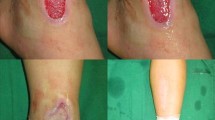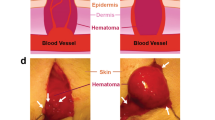Summary
BACKGROUND: Fibrin sealants find applications in many surgical fields (e.g., plastic and reconstructive surgery) where a slower setting time of about 30 to 60 s is beneficial. This can be achieved by diluting the thrombin component of the fibrin sealant to a concentration of about 5 IU/ml. This work was carried out to define an optimal dilution medium for thrombin which maintains all relevant functional parameters of the fibrin sealant and which is easy to prepare with components available in most operating theaters. METHODS: Different performance criteria of a fibrin sealant were tested in vitro by the following methods: adhesive strength in a rat skin adhesion model, turbidimetry and scanning electron microscopy to determine the fibrin clots structure, tensile strength of the fibrin clots by measuring the force at break. The cross-linking of the fibrin sealant by factor XIII (FXIII) as a function of the calcium concentration was assessed by quantitative electrophoresis. RESULTS: A dilution medium containing only calcium chloride in a concentration of about 20 mM performed best in most of the applied test systems. Dilution media with high ionic strength resulted in clots with low adhesive and tensile strength, thin fibrin fibers, and low clot elasticity. Dilution media without calcium prevented proper cross-linking of the resulting fibrin clots and led to clots with low tensile and adhesive strength. CONCLUSIONS: We present an optimized simple dilution protocol for the dilution of the thrombin component for a slowly setting fibrin sealant.
Zusammenfassung
GRUNDLAGEN: Bei vielen chirurgischen Anwendungen (z. B. plastische und rekonstruktive Chirurgie) von Fibrinkleber ist eine längere Verarbeitungszeit von etwa 30–60 s vorteilhaft. Das kann durch eine Verdünnung der Thrombin-Komponente auf etwa 5 IU/ml erreicht werden. Ziel dieser Studie war es, ein optimales Verdünnungsmedium für die Thrombin-Komponente zu definieren, welches einerseits keine Veränderungen in den funktionellen Parametern des Fibrinklebers mit sich bringt und andererseits einfach und mit im OP vorhandenen Bestandteilen hergestellt werden kann. METHODIK: Folgende Methoden kamen zur In-vitro-Beurteilung der Verdünnungsmedien zum Einsatz: Klebefestigkeit im Rattenhaut-Modell, Turbidimetrie und Rasterelektronenmikroskopie zur Bestimmung der Clot-Struktur, Reißfestigkeit der Fibrinclots durch Messen der zum Reißen nötigen Kraft. Die Fibrin-Quervernetzung in Abhängigkeit der Ca2+-Konzentration wurde durch quantitative Elektrophorese bestimmt. ERGEBNISSE: Das Verdünnungsmedium, das in vielen Kriterien die besten Ergebnisse gezeigt hat, enthält nur Kalziumchlorid in einer Konzentration von etwa 20 mM. Verdünnungsmedien mit einer zu hohen Ionenstärke ergaben Clots, die durch schlechte Reiß- und Klebefestigkeit, dünne Fibrinfasern und geringe Clot-Elastizität gekennzeichnet waren. In Abwesenheit von Kalzium kam es zu schlechter Fibrinquervernetzung und daraus resultierend zu schwachen und schlecht adherierenden Fibrinclots. SCHLUSSFOLGERUNGEN: Das optimale Verdünnungsmedium für die Verdünnung von Thrombin für einen langsamer bindenden Fibrinkleber wird angegeben.
Similar content being viewed by others
Author information
Authors and Affiliations
Corresponding author
Rights and permissions
About this article
Cite this article
Goessl, A., Redl, H. Optimized thrombin dilution protocol for a slowly setting fibrin sealant in surgery. Eur Surg 37, 43–51 (2005). https://doi.org/10.1007/s10353-004-0115-2
Received:
Accepted:
Issue Date:
DOI: https://doi.org/10.1007/s10353-004-0115-2




